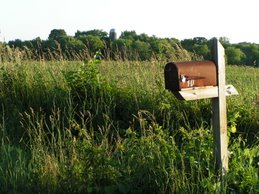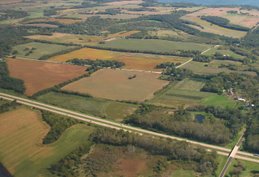The word is out. Professor Cal DeWitt has sleuthed some amazing and disturbing facts out of the recesses of our aquifers. At Tuesday night’s Planning Commission meeting, he explained the relationship he discovered between Fitchburg’s deep-aquifer, high-capacity Well #10 (located on Granite Circle) and the 125-year-old, upper-aquifer, cased artesian Well #8 (located at Nevin Springs Fish Hatchery). It had been assumed that both wells were drawing from separate aquifers based on their depth profiles (800 feet or more for Well #10 and 180 feet for Well #8), and one mile distance from each other. However, Professor DeWitt found a significant correlation between them that changes the original assumptions.
Nevin Springs was producing 400 gallons of water per minute (gpm) for a number of years until late 2001 when it started dropping. It has since continued at a lower rate of 300-350 gpm. A mile away, Well #10 started pumping in 2001 and within a year was pumping around 600k gallons per day.
As shown in one of his graphs, a pattern appears when comparing the flow volume drawn by the new, municipal well and the decreased flow, about 12 months later, from the artesian well.
The bottom line? About 10% of the pumpage of Well #10 is equal to the losses at Well #8 that show up after a 12-month lag. So, there is a connection between these wells in the upper and lower aquifers and water is traveling at the rate of 14.5 feet per day from Nevin Springs in the direction of the Granite Circle well.
The fact that Professor DeWitt was able to find this relationship buried in the data from many area wells is surprising enough but I received another shock when he told us that we don’t really know how this happens. It appears that, at least sometimes, the upper and lower aquifers are indeed connected even though they separated by an aquitard (made of layers of sedimentary rock) which limits vertical waterflow except in cracks. To complicate matters, the horizontal flow between these two wells is 10s of thousands of times greater than the vertical rate of water flow through the aquitard, perhaps because of long horizontal pipes that formed over the years.
What does this mean? Professor DeWitt urges us to consider the entire groundwater hydrology system before we do something that would stop the flow of water to important springs and lakes in the area. For example, if we turn off Deep Spring and other groundwater resources that refresh Lake Waubesa, the entire southern boot (most of the lake) would die (eutrophy). And distance does indeed make a difference when dealing with solutions. The farther away we stay from precious water resources, the better chance we have to protect them. So, locating any new well in the vicinity of the NE Neighborhood is more of a threat to Lake Waubesa and the natural resources because of its impact on groundwater flow to the watershed.
Although this bombshell was dropped during the agenda item for the NE Neighborhood and Stormwater Plans, it also must be considered for all well drilling activity and increased water use (ie. development) in Fitchburg and beyond. If we fail to consider how new high-capacity wells will draw groundwater from the surrounding area, other springs or wells (including private wells) could dry up. This has happened with many of the famed springs of Waukesha and the Little Plover River in Stevens Point, among others.
[Side Track: According to Devil in the White City by Erik Larson (link here), one entrepreneur wanted to pipe water from a Waukesha spring on his property all the way to Chicago to supply the 1893 World’s Fair. But, Waukesha residents didn’t want the water to leave the city and they showed up with guns, knives and pitchforks to stop the pipeline workers, returning at 2 am with a cannon (!) to drive away them away again. For the rest of the story, see the Lake Lore article on page 4 of the Alliance for the Great Lakes newsletter here.]
Fast forward to Fitchburg 2007.
Professor DeWitt explained the concept and vital need for Groundwater and Watershed Budgets which he likened to other budgets. Simply put, we need to know how much we are depositing (infiltration) into each aquifer and withdrawing (wells and springs) from each aquifer to be sure that we don’t overdraw our account and live beyond our means. To protect against this, he suggests that the City of Fitchburg recommend to Dane County and CARPC (Capital Area Regional Planning Commission) that:
1. they place high priority on developing a policy for a Groundwater Budget for the region; and
2. they work with Fitchburg on procedures for monitoring and evaluating diminished well and spring flow to the city and region.
I am happy to report that, after the presentation, applause (normally against the rules at these meetings) was allowed to acknowledge Professor DeWitt’s efforts, and the Planning Commissioners wisely responded to these sobering data by asking for more information before making a decision about the NE Neighborhood. I’m not sure if they actually ordered a Groundwater Budget but I think that prospect is at least on the radar if not the table.
(NOTE: FACTv recorded the entire meeting including Professor DeWitt's presentation. So, you can contact them to have a DVD made of all or part of the meeting or to rebroadcast it during their Thursday morning request slot. If that doesn't work for you, drop me an email at fitchburgvoices@gmail.com to borrow my copy.)
Monday, September 10, 2007
Water, Water... Anywhere?
Posted by
Terry Carpenter
at
3:45 PM
![]()
Categories Books, Cal DeWitt, NE Neighborhood Plan, NEN, Plan Comm Meetings, Sustainability, Water Resources



1 comment:
Cal DeWitt's testimony to the Plan Commission certainly was an important step forward in the understanding of the relationships between different underground aquifers and surface waters.
It also underscored some timeworn truths that policymakers still have a tough time understanding.
Foremost among them is that our stewardship responsibilities to the land we inhabit don't stop at the city limits.
The environment recognizes no political boundaries. Neither does environmental degradation. Maybe that's why it's the tremendous cost that is seldom factored into "cost-benefit" calculations.
Similarly, the stewardship responsibilities of the citizens of Fitchburg, of Fitchburg's Plan Commission or of city government as a whole don't stop at the arbitrary boundaries that separate Fitchburg from other municipalities on the map.
Ed Kinney's question to Cal DeWitt (I'm paraphrasing), "What has the town of Dunn done to protect Lake Waubesa?" was a valid question, but it seemed to imply a "You first" attitude. An attitude that says, "If you haven't done anything to protect the watershed, we shouldn't have to do anything either."
DeWitt parried that potential argument by citing a number of examples of Dunn protecting our shared natural resources, and he acknowledged that more needs to be done to correct mistakes of the past.
Has Fitchburg been similarly scrupulous in protecting our shared natural resources? Has the city acted responsibly? Have we as individuals acted responsibly?
Those are questions well worth pondering.
Post a Comment